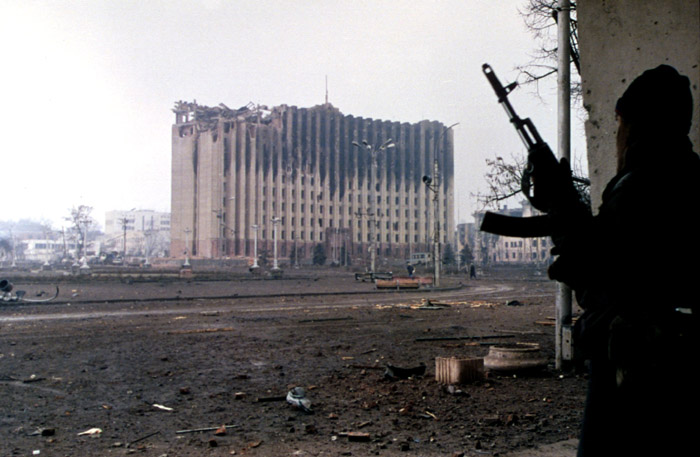The Trump Administration’s Flawed Guantánamo Narrative
On Saturday, I wrote a post for Just Security titled “Whitewashing Guantánamo,” in which I explained how three different data points from the past week underscored a consistent and troubling pattern by the Trump administration—to rewrite the history of Guantánamo in a way that seeks to take the Bush Administration off the hook (“it was those pesky judges’ fault”), and to blame the Obama Administration for all recidivism by former detainees (the data is conclusively to the contrary) and for the plodding pace o
Published by The Lawfare Institute
in Cooperation With

On Saturday, I wrote a post for Just Security titled “Whitewashing Guantánamo,” in which I explained how three different data points from the past week underscored a consistent and troubling pattern by the Trump administration—to rewrite the history of Guantánamo in a way that seeks to take the Bush Administration off the hook (“it was those pesky judges’ fault”), and to blame the Obama Administration for all recidivism by former detainees (the data is conclusively to the contrary) and for the plodding pace of the malingering military commissions (as they continue to be dogged by jurisdictional issues all of which first arose prior to January 2009).
I imagine that yesterday’s excellent post by my friend John Bellinger was in response to the same catalysts—the Trump/Spicer/Sessions narrative I outlined in my post. Writing to “remind readers why Guantanamo was opened and why I believe it should now be closed,” John explains why, in retrospect, we should understand the government’s decision in Fall 2001 to open the detention facility there, and why it’s nevertheless now a good idea to wind it down—because allowing it to persist “will produce more (and more risky) lawsuits; difficult practical problems down the road as to what to do with the detainees; and unnecessary friction with allies.” As with so much of what John writes, this is an important contribution—and one from someone who was literally “in the room where it happened.” Indeed, I suspect it says a lot that, although we come from such different perspectives and backgrounds, John and I reacted so similarly to the same prompts.
John frames his post as an effort to clarify the history of Guantánamo “for those new to the controversy.” With that in mind, I thought I’d flag two points of emphasis on which John and I disagree (perhaps sharply)—not because I think either detracts from our mutual bottom line, but because, even in the age of Trump, I suspect (or at least hope) that there’s still value in such nuanced disagreements:
First, John’s post downplays a point that I firmly believe to be true—that a major part of the reason why hundreds of detainees were sent to Guantánamo was in the hope that detention there (as opposed to in the United States—where we held hundreds of thousands of POWs during World War II) would evade judicial review. As John cogently explains, it was clear by December 2001 that the United States would need a facility in which to house individuals captured as part of the armed conflict with al Qaeda and its affiliates—and that, for obvious reasons, holding the detainees in theater was less than optimal. And unlike the civil liberties groups John critiques in his post, I agree that, at least for individuals captured in the context of active combat operations (which, it should be said, does not describe everyone who we held at Guantánamo), military detention was a legally available option.
But John critiques as “revisionist history” the view that Guantánamo was selected at least largely because the federal courts’ jurisdiction over the facility was unsettled—even as he concedes that it “was certainly one factor.” Other factors, he writes, “included the need to find a completely secure facility outside Afghanistan that was available immediately, convenient to the United States, relatively low-cost, and that had sufficient supporting infrastructure for both the detainees and guard force.”
Again, John was in the room, and I wasn’t, but those same criteria were easily satisfied by any number of facilities within the territorial United States (and, I dare say, at far less cost than the over $1 billion we’ve poured into Guantánamo). But don’t take my word for it; at the end of that same critical month (December 2001), Patrick Philbin and John Yoo wrote a memo for the Office of Legal Counsel that specifically advised the Department of Defense “that the great weight of legal authority indicates that a federal district court could not properly exercise habeas jurisdiction over an alien detained at [Guantánamo Bay].” In his dissent in Boumediene, Justice Scalia seized on this passage—explaining that, “[h]ad the law been otherwise, the military surely would not have transported prisoners there, but would have kept them in Afghanistan, transferred them to another of our foreign military bases, or turned them over to allies for detention.” John may well believe it to be a coincidence that, just two weeks after that memorandum was sent (at the apparent request of the Department of Defense), the first non-citizens were shipped to Cuba. Like Justice Scalia, I disagree.
The second point on which John and I appear to differ involves how much emphasis we place in telling Guantánamo’s history on the government’s torture and other cruel, inhuman, and degrading treatment of the detainees. John’s post, of course, wasn’t about those abuses, which he refers to in a block quote from an earlier post in which he rightly held out “detainee abuse” as one of the ways the Guantánamo program was “mishandled.” Indeed, I don’t mean by this passage to criticize John, who, unlike many of his contemporaries within the government, does not deny either the abuses or their deleterious ramifications, as his Lloyd Cutler Lecture on the Rule of Law, delivered last November at the Supreme Court, makes abundantly clear.
My point is more specific to the current climate, in which I don’t think it’s possible to tell Guantánamo’s story without paying more heed to the mistreatment of detainees. And tortured, the detainees were. That fact—yes, President Trump, FACT—is the principal source of all of the baggage that surrounds Guantánamo. It is also the primary cause of the difficulties that President Bush, President Obama, John, and countless others have identified from Guantánamo’s continued operation: Its use as a propaganda and recruiting tool for terrorists, and the difficulties that it has created for our relations with our foreign allies. Just to tie these points together, the abuses of detainees also likely had a lot to do with why the courts, contra the December 2001 OLC memo, did assert jurisdiction over Guantánamo—jurisdiction that led, whether directly (as in Hamdan’s holding that Common Article 3 of the Geneva Conventions applied to the conflict between the United States and al Qaeda) or indirectly (through the specter of direct review of torture claims), to the cessation of the most problematic interrogation practices. That is to say, these two points of emphasis are, in my view, closely related—and central to any narrative about Guantánamo’s troubled history because of both their historical value and their important lessons for the current Administration.
This is not to say that anyone, like John, who was even involved in these discussions and decisions bears responsibility for the abuses. Quite to the contrary. Unlike some of my friends, I have no doubt that numerous government lawyers, John included, were as troubled by the allegations (and subsequent documentation) of torture and other detainee abuses as were we on the outside—and played at least as large (if not an even larger) role behind the scenes in helping to hasten the demise of such brutal, unproductive, and unlawful interrogation practices. And it’s vitally important that folks like John, far more than me, take a lead role in pushing back against the Trump administration’s effort to rewrite Guantánamo’s history, and to help make the important point that the case for reinvigorating Guantánamo today is not the same as the case for opening it in the first place—as he does in his post.
Where John and I may ultimately disagree, though, is the significance of abusive interrogation techniques—and the concomitant importance of evading judicial process—to the narrative of how we got Guantánamo in the first place, or of why the closure of Guantánamo, wholly unrelated to the termination of the United States’ detention program, is such an important policy objective going forward. The more that we lose sight of both of these points, the more I fear that we will allow the Trump administration’s whitewashing to take root—and, potentially, to repeat the worst missteps of our post-September 11 history in response to some future crisis.


-(1).jpg?sfvrsn=2f7409f8_5)


